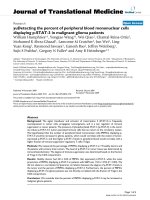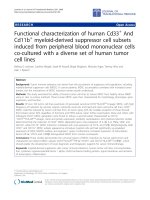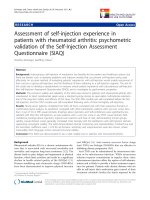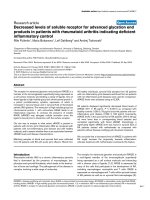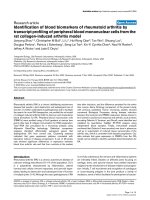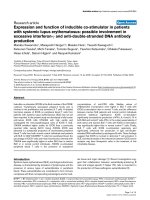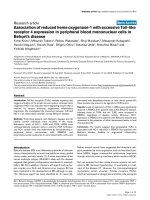Expression of the receptor activator of nuclear factor-kB ligand in peripheral blood mononuclear cells in patients with acute Charcot neuroarthropathy
Bạn đang xem bản rút gọn của tài liệu. Xem và tải ngay bản đầy đủ của tài liệu tại đây (422.62 KB, 6 trang )
Int. J. Med. Sci. 2016, Vol. 13
Ivyspring
International Publisher
875
International Journal of Medical Sciences
Research Paper
2016; 13(11): 875-880. doi: 10.7150/ijms.14579
Expression of the receptor activator of nuclear
factor-kB ligand in peripheral blood mononuclear cells in
patients with acute Charcot neuroarthropathy
Alberto Bergamini1, Francesca Bolacchi2, Caterina Delfina Pesce1, Giada Veneziano1, Luigi Uccioli3,
Valentina Girardi2, Laura De Corato2, Maria Teresa Mondillo2, Ettore Squillaci2
1.
2.
3.
Department of Internal Medicine, Hematology/Oncology Unit, Tor Vergata University, Rome, Italy Department of Public Health and Cellular Biology,
University of Rome "Tor Vergata", Rome, Italy
Department of Diagnostic and Molecular Imaging, Radiation Therapy and Interventional Radiology, University Hospital Tor Vergata, Rome, Italy
Department of Systems Medicine, University of Rome Tor Vergata, Rome, Italy
Corresponding author: Francesca Bolacchi, M.D., PhD., Department of Diagnostic and Molecular Imaging, Radiation Therapy and Interventional Radiology,
University Hospital Tor Vergata, Viale Oxford 81 00133 Rome Italy. Tel. 06-20902374 Email:
© Ivyspring International Publisher. Reproduction is permitted for personal, noncommercial use, provided that the article is in whole, unmodified, and properly cited. See
for terms and conditions.
Received: 2015.12.02; Accepted: 2016.07.08; Published: 2016.10.20
Abstract
Introduction. The receptor activator of nuclear factor-kB (RANK), ligand (RANK-L) and
osteoprotegerin (OPG) are implicated in the pathogenesis of acute Charcot neuroarthropathy
(CN).
Materials and Methods. This study aimed to investigate the expression of RANK-L and OPG in
peripheral blood mononuclear cells (PBMC) from patients with acute CN.
Results. We found that the expression of RANK-L was lower in patients with acute CN as
compared with diabetic control subjects and healthy control participants; whereas OPG
expression was not detected in patients and in both control groups. RANK-L expression at the
onset of disease was inversely correlated with the index of polyunsaturation (PUI), a bone marrow
MRS-derived measurable index that allows evaluation of disease activity in acute CN, and recovery
time. Finally, the expression of RANK-L increased at the time of healing compared with the values
found during the acute phase.
Conclusions. In conclusion, our preliminary data provide a first step in applying analysis of
RANK-L expression in peripheral blood cells to the diagnosis of acute CN. Based on our data we
also suggest that analysis of RANK-L expression could be a complementary tool that can be
employed to obtain quantitative parameters that may help clinicians to monitor disease activity in
patients with acute CN.
Key words: Charcot neuroarthropathy, receptor activator of nuclear factor-kB, peripheral blood cells.
Introduction
Charcot neuroarthropathy (CN) typically occurs
in the foot/ankle of diabetic patients with sensory
neuropathy and it is a common cause of morbidity in
this population. This disease can lead to a severe
amputation of feet: in such cases, osteomyelitis has
been described as trigger mechanisms of developing
CN, thus an effective antibiotic therapy could have a
positive role in the course of the disease. CN is early
characterised by acute inflammation that may cause
osteopenia, bone resorption and bone weakening
which subsequently may lead to chronic bone
alterations such as fractures, dislocations, instability
and gross deformities 1-3. Indeed, local inflammation
is associated with the release of proinflammatory
cytokines such as interleukin (IL)-1alpha and tumor
necrosis factor (TNF)-alpha, which are known
mediators of bone resorption via excess osteoclastic
activity 4,5. These cytokines lead to an increased
Int. J. Med. Sci. 2016, Vol. 13
expression of the receptor activator of nuclear
factor-kB (RANK) ligand (RANK-L). Its receptor
(RANK) is expressed in the membrane of
preosteoclasts. RANK-L stimulates the expression of
nuclear factor (NF)-kB that, in turn, induces the
maturation of precursor cells into mature osteoclasts.
At the same time, NF-kB induces the glycoprotein
osteoprotegerin (OPG), which acts as a decoy receptor
for RANK-L to avoid excess osteolysis. The role of this
pathway in acute CN pathogenesis is supported by
the fact that the same RANK/RANK-L/OPG system
is also involved in the process of medial arterial
calcification a feature that is strongly associated with
CN 6,7. Activated T- and B-cells are well-recognized
sources of RANK-L and OPG 8,9, and may contribute
to pathological bone resorption seen in chronic
inflammatory diseases such as rheumatoid arthritis
(RA), periodontitis and inflammatory bowel disease
10-13. Acute CN is not associated with systemic
inflammation 14, however, peripheral monocytes from
patients with acute CN may show pro-inflammatory
changes 15.
On the basis of these evidences, in this study the
expression of RANK-L and OPG was investigated in
peripheral blood mononuclear cells (PBMC) from
patients with acute CN and correlated with clinical
and radiological markers of disease activity. We
found that the expression of RANK-L was lower in
patients with acute CN as compared with diabetic
control subjects and healthy control participants;
whereas OPG expression was not detected in patients
and in both control groups. RANK-L expression at the
onset of disease was inversely correlated with the
index of polyunsaturation (PUI), a bone marrow
MRS-derived measurable index that allows
evaluation of disease activity in acute CN 16, and
recovery time. Finally, the expression of RANK-L
increased at the time of healing compared with the
values found during the acute phase.
Materials and Methods
Patients recruitment
Nine diabetic patients with acute CN were
prospectively enrolled in the study. Acute CN was
defined based on the following clinical and MRI signs:
unexplained, relatively painless, increasing swelling
of a foot and ankle, skin temperature increase of at
least 2°C compared with the contralateral foot
(delta-T), clinical instability due to ligamentous
injury/occult trauma, presence of typical bone
marrow oedema on MRI. All patients were in stage 0,
according to Eichenholtz stage system and were free of
any structural bone or articular alteration, as
documented by computed tomographic evaluation,
876
active foot ulceration and/or signs of soft tissue
infection. All patients had unilateral foot involvement
as documented by MRI (no evidence of bone marrow
oedema), as well as clinical evaluation. All patients
displayed severe peripheral sensory polyneuropathy.
The presence of peripheral neuropathy was assessed
by the vibration perception threshold (VPT expressed
in Volts) and diabetic neuropathy index (DNI).
Peripheral neuropathy was defined by a VPT ≥25
Volts and/or a positive DNI score >2 points 17.
Following the diagnosis of acute CN, all patients
underwent foot offloading and immobilisation by
serial total contact casting with progression to
removable cast walkers. Recovery was defined by the
disappearance of bone marrow oedema as evidenced
demonstrated on MRI using T2-weighted short tau
inversion recovery (STIR) images. A group (n=9) of
diabetic
patients
with
peripheral
sensory
polyneuropathy, without clinical and radiological
evidence of the history of CN was also studied.
Healthy controls (n=9) with no evidence of diabetes
mellitus (according to self-reported absence of
antidiabetic medication), were also included. This
study was conducted according to the principles
expressed in the Declaration of Helsinki and
approved by our institutional review board. Informed
consent was obtained from all subjects before the
performance of the study.
RT-PCR
Total RNA was isolated in patients and controls
within 24h of meeting enrolment criteria using using
RNeasy Plus Mini Kit (Qiagen, Hombrechtikon,
Switzerland), inclusive of DNase-I digestion, and then
ethanol precipitated. Quantitation of isolated RNA
was performed by spectrophotometric determination
(Gene Quant II, Pharmacia, Uppsala, Sweden). Total
RNA was reverse-transcribed to cDNA using
Omniscript RT Kit (Qiagen): RNA (1microgram) was
added to one reaction tube containing 2microliters 10x
Buffer RT, 2microliters dNTP Mix (5mM each dNTP),
2microliters Oligo dT primer (10microM), 2microliters
Random
hexamers
(100microM),
1microliter
Qiagen-RNase inhibitor (10 units/microl), 1microliter
Omniscript Reverse Transcriptase (4 units/microl),
variable amount of RNase-free water in a total
reaction volume of 20microliter. Incubation
conditions were 60 min at 37°C. Serial dilutions of
cDNA were amplified by PCR using AmpliTaq Gold
360 DNA Polymerase (Applied Biosystems): cDNA
was added to one reaction tube containing
5microliters 10x AmplTaq Gold 360 Buffer,
5microliters 25mM Magnesium Chloride, 4microliters
dNTP Mix (2.5mM each dNTP), 1microliter of each
primer (25microM), 0.25microliters AmpliTaq Gold
Int. J. Med. Sci. 2016, Vol. 13
360 DNA Polymerase (5 units/microliter), PCR-grade
water in a total reaction volume of 50microliters. The
reaction was performed on GeneAmp PCR System
9700 (Applied Biosystems). Human primers specific
for mRNA from RANK-L and OPG genes were used
in PCR, beta-actin was the housekeeping gene
selected as internal standard. The primers used were:
RANK-L forward, 5’-CAGATGGATCCTAATAGA
AT-3’, RANK-L reverse, 5’-ATGGGAACCAGA
TGGGATGTC-3’, OPG forward, 5’-ATGAACAA
GTTGCTGTGCTG-3’, OPG reverse, 5’-GCAGAACT
CTATCTCAAGGTA-3’, beta-actin forward, 5’-CGTA
CCACTGGCATCGTGAT-3’,
beta-actin
reverse,
5’-GTGTTGGCGTACAGGTCTTTG-3’.
Thermal
profile to amplify DNA was: initial denaturation at
95°C for 10 min followed by a selected number of
cycles consisting of denaturation at 95°C for 1 min,
annealing (at temperature depending on T melting
temperature of each primer pair) for 30 sec, extension
at 72°C for 1 min, with a final extension at 72°C for 7
min. The annealing temperature was: 54°C for OPG,
46°C for RANKL, 58°C for beta-actin. The number of
cycles was: 35 for RANK-L, 50 for OPG, 21 for
beta-actin. The length of the amplification product
was: 324 bp for RANK-L, 354 bp for OPG, 452 bp for
beta-actin. The absence of DNA contamination in the
RNA preparation was verified performing HLA-DQa
1 locus PCR amplification (forward primer GH26,
5-GTGCTGCAGGTGTAAACTTGTACCAG-3’,
reverse primer GH27, 5’-CACGGATCCGGTA
GCAGCGGTAGAGTTG-3’, annealing temperature
60°C, size of product 242 bp, or 239 bp from some
alleles). 10ml of the amplification product from each
PCR were separated on 1.8% agarose gel, stained with
ethidium bromide and visualized by UV irradiation.
Ethidium bromide bands were acquired by scanning
and
quantified
by
image
analysis
with
Multi-Analyst/PC (PC software for Bio-Rad’s Image
Analysis Systems Version 1.1.)
MR Examinations
MRS and MRI were performed using a 3-T
scanner system (Achieva, Philips Medical Systems,
Best, the Netherlands). Presence or absence of bone
marrow oedema within different bones of the foot and
ankle was determined using T2-weighted short tau
inversion recovery (STIR) images acquired in the
coronal, axial and sagittal planes. Spectroscopic data
were obtained as previously described using a
single-voxel point-resolved spectroscopic sequence
(PRESS) as previously described 16. In brief, the PRESS
sequence was water suppressed using a selective
excitation pulse to crush the water signal. The voxel
(volume of interest, VOI) size was 1.3×1.3×1.3 cm3.
Fully automated frequency determination, power
877
optimization, and shimming phases were performed
in the VOI. To confirm the reproducibility of the
measurements, three sets of spectra acquisition were
repeated three times each in four 4 patients and six 6
control subjects. Data were analyzed with using the
jMRUI v4.0 software package 18. Metabolites to be
estimated were defined with a reference database of
known peaks 19. The acquired spectra were analyzed
with using the AMARES algorithm. The metabolite
ratio index of poly-unsaturation (PUI) was defined as
previously described 16.
Results
Clinical outcomes
The general clinical characteristics of the
different patient groups are presented in Table 1. The
mean age, male to female ratio were similar between
acute CN patients, and diabetic control subjects
(p>0.05 and p>0.05, respectively) or healthy control
participants (p>0.05 and p>0.05, respectively). Also,
the time since onset of diabetes and percentage of
Hba1c were not different between acute CN patients,
and diabetic control subjects (p>0.05 and p>0.05,
respectively). All diabetic patients were on insulin
therapy. The lesion site in acute CN patients was
hind-foot, n= 6; mid-foot, n= 3 and the mean healing
time on MRI was 8.14 ± 3.7 months.
Table 1: General characteristics of study patients
Age (years, mean ± SD)
Sex (male:female)
Type1:type2 diabetes
Time since onset of diabetes
(years, mean ± SD)
Hba1c (%, mean ± SD)
Charcot
Diabetes
54.4 ± 4.5
3:6
6:3
18.34 ± 11.3
60.11 ± 4.3
4:5
5:4
22.7 ± 12.5
Healthy
controls
48.89 ± 5.1
5:4
n.a.
n.a.
7.4 ± 3.1
8.1 ± 2.2
n.a.
Note. n.a.= not applicable
RANK-L and OPG expression in PBMC
Semi-quantitative RT-PCR was performed on
total RNA extracted from PBMC in acute CN patients,
diabetic control subjects and healthy control
participants. As shown in Figure 1, RANK-L
expression was detected in the totality of patients and
controls but was significantly lower in patients as
compared to controls, as demonstrated by
densitometric evaluation of the amplification
products from PCR. No significant differences in
RANK-L expression were documented between
diabetic control subjects and healthy control
participants. Abundant OPG expression was
evidenced in the control positive cell line U937 but, at
Int. J. Med. Sci. 2016, Vol. 13
variance with RANK-L, no OPG expression was
detected in PBMC from patients and controls.
RANK-L expression correlates with PUI and
recovery time
We then investigated whether RANK-L
expression in acute CN patients was correlated with
PUI and healing time on MRI. Pearson’s correlation
analysis showed RANK-L expression was inversely
correlated with PUI levels (r=-0.7072, 95% confidence
interval = -0.9331 to -0.0810, P=0.033) and recovery
time (r=-0.7878, 95% confidence interval = -0.9532 to
-0.2592, P=0.011) (Fig. 2).
878
products from PCR did not show a significant
difference of RANK-L expression between the two
time points; however, in all patients the expression of
RANK-L increased at the time of healing compared
with the values found during the acute phase.
Recovery from acute CN is associated with
increase of RANK-L expression
RANK-L expression was analyzed in six patients
during the acute phase of CN and at time of bone
marrow
oedema
disappearance
(Fig.
3).
Densitometric evaluation of the amplification
Figure 1. RT-PCR RANK-L expression in the 3 typologies of subjects
investigates: Healthy controls, Diabetic controls and Charcot patients.
Figure 2. RT-PCR RANK-L expression in acute Charcot patients evaluated on the basis of the index of polyunsaturation (PUI) and of the healing time on MRI.
Figure 3. RANK-L expression analyzed in Charcot patients in 2 time-points:
during the acute phase of Charcot neuropathy and at time of bone marrow
oedema disappearance.
Discussion
The
involvement
of
RANK-L-mediated
osteoclastic resorption in acute CN is supported by
several studies 6,7. The adaptive immune system
potently impacts the skeleton via a convergence of
immune cells and cytokine effectors, mediating
critical functions in both organ systems and forming
the ‘‘immuno-skeletal interface’’. Under inflammatory
conditions both B and T cells can be considerable
sources of RANK-L and may contribute to
pathological bone resorption 10-13. However, in acute
CN the local inflammatory response related to
increased pro-inflammatory cytokine secretion is not
associated with a systemic inflammatory syndrome
(14). Here we found that the expression of RANK-L
was lower in PBMC from patients with acute CN as
compared with diabetic control subjects and healthy
controls. These data suggest the existence of a
compensatory immunoregulatory mechanisms to
potentially limit bone resorption during acute CN.
Down-modulation of RANK-L expression could be
obtained by either reduced production of cytokines
such as IL-18, IL-1beta and TNF-alpha, that increase
Int. J. Med. Sci. 2016, Vol. 13
RANK-L production by lymphocytes 20, or by
increased secretion of cytokines, such as IL-27, able to
inhibit expression of RANK-L on T cells 21-24. In
contrast to RANK-L, no OPG expression was detected
in cells from patients and controls. This is not
surprising since lymphocytes express OPG only upon
activation in response to antigen challenge, which is
not a pathogenic mechanism of acute CN. Notably,
absence of OPG expression by PBMC is consistent
with the intense bone resorption that characterizes the
acute phase of CN.
Acute CN typically presents with acute or
sub-acute inflammation of the foot. Pain may or may
not be present, depending on the presence of nerve
damage 5. There is neither fever nor any major
biological inflammatory syndrome, and this clinical
presentation has often led to inaccurate or delayed
diagnosis, resulting in progression to the chronic
phase
with
irreversible
deformation.
Early
recognition of CN can save a long period of suffering
for the patient, high hospital costs and ultimately
amputation. However, at this stage of disease
standard radiography often can not distinguish acute
CN from other conditions. Radioisotope technetium
(TC-99m) bone scintigraphy has good sensitivity but
poor specificity for osseous pathology 25. MRI is able
to evidence inflammation in the bone and in the
adjacent soft tissues, but it is quite expensive and
requires a high degree of expertise by the examiner 26.
The data we present here suggest that evaluation of
RANK-L expression in peripheral blood cells may
represent a possible new diagnostic tool. However,
differential diagnosis of acute CN is to be made with
infections (osteomyelitis, cellulitis, septic arthritis)
and inflammations (i.e. gout). We did not evaluate
RANK-L expression in subjects with infection or
inflammation other than CN, thus, future work
should focus, other than on confirmatory analysis, on
discrimination of infection/inflammation vs. CN.
Up to now the evaluation of acute CN patients
has relied on local inflammatory signs such as skin
temperature, swelling and erythema 5,27,28. Local
clinical signs are useful to guide the physician to shift
from the cast to other pressure relieving devices.
However, they are affected by poor specificity and
reproducibility and their utility in providing a
measure of disease activity level has been recently
questioned 29,30. The lack of specific criteria and
objective indices able to assess the disease activity
during follow-up, in addition to being a hindrance to
the implementation of current physical therapeutic
options has also limited research concerning
pharmacological treatments for acute CN. Recently,
MRI has been introduced in the evaluation of acute
CN. In particular, the disappearance of bone marrow
879
oedema as evaluated on STIR images has proved
useful in assessing disease recovery 31. However,
during the period in between disease onset (presence
of bone marrow oedema) and recovery (absence of
bone marrow oedema) the regression of bone marrow
oedema is difficult to quantify 32. The use of contrast
enhanced MRI has been advocated 32,34. However,
repeated contrast enhanced examinations are not
always feasible in diabetic patients 34. In this clinical
contest, a quantitative non-invasive index would be
highly desirable to monitor disease activity. In this
regard, we show here that the degree of RANK-L
expression in PBMC from acute CN patients
correlates with the intensity of bone marrow
inflammation, as assessed by MRS. Also, RANK-L
expression was significantly lower in patients whose
marrow edema took longer to resolve. Finally, after
bone marrow oedema disappearance the expression
of RANK-L evaluated on a single patient basis
increased with respect to the values obtained at the
onset of disease.
Conclusions
In conclusion, our preliminary data provide a
first step in applying analysis of RANK-L expression
in peripheral blood cells to the diagnosis of acute CN.
RANK-L expression could be related to a wide range
of degenerative bone pathologies, such as rheumatoid
arthritis, thus a proper differential diagnosis must be
performed. The pathogenesis of CN remains
uncertain and however, based on our data, we
suggest that analysis of RANK-L expression could be
a complementary tool that can be employed to obtain
quantitative parameters that may help clinicians to
monitor disease activity in patients with acute CN.
Authors' Contributions
Authors equally contributed to this study.
Competing Interests
The authors have declared that no competing
interest exists.
References
1.
2.
3.
4.
5.
6.
Nielson DL, Armstrong DG. The natural history of Charcot’s
neuroarthropathy. Clin Podiatr Med Surg. 2008; 25:53-62
Chantelau E. The perils of procrastination: effects of early vs. delayed
detection and treatment of incipient Charcot fracture. Diabet Med. 2005;
22:1707-1712
Greenstein A, Jarrett SJ, McGonagle D. Acute neuropathic joint disease: a
medical emergency? Diabetes Care. 2005; 28:2962-2964
Baumhauer JF, O'Keefe RJ, Schon LC, Pinzur MS. Cytokine-induced
osteoclastic bone resorption in charcot arthropathy: an immunohistochemical
study. Foot Ankle Int. 2006; 27:797-800
Petrova NL, Moniz C, Elias DA, Buxton-Thomas M, Bates M, Edmonds ME. Is
there a systemic inflammatory response in the acute charcot foot? Diabetes
Care. 2007; 30:997-998
Sinha S, Munichoodappa CS, Kozak GP. Neuro-arthropathy (Charcot joints) in
diabetes mellitus (clinical study of 101 cases). Medicine (Baltimore). 1972;
51:191-210.
Int. J. Med. Sci. 2016, Vol. 13
7.
8.
9.
10.
11.
12.
13.
14.
15.
16.
17.
18.
19.
20.
21.
22.
23.
24.
25.
26.
27.
28.
29.
30.
31.
32.
33.
Clouse ME, Gramm HF, Legg M, Flood T. Diabetic osteoarthropathy. Clinical
and roentgenographic observations in 90 cases. Am J Roentgenol Radium Ther
Nucl Med. 1974;121:22-34
Wong BR, Josien R, Lee SY, et al. TRANCE (Tumor necrosis factor
[TNF]-related Activation-induced Cytokine), a new TNF family member
predominantly expressed in t cells, is a dendritic cell-specific survival factor.
The Journal of Experimental Medicine. 1997; 186:2075-2080
Yun TJ, Chaudhary PM, Shu GL, et al. OPG/FDCR-1, a TNF receptor family
member, is expressed in lymphoid cells and is up-regulated by ligating CD40.
J Immunol. 1998; 161:6113-6121
Haynes DR, Crotti TN, Loric M, Bain GI, Atkins GJ, Findlay DM.
Osteoprotegerin and receptor activator of nuclear factor kappaB ligand
(RANKL) regulate osteoclast formation by cells in the human rheumatoid
arthritic joint. Rheumatology (Oxford). 2001; 40:623-630.
Theill LE, Boyle WJ, Penninger JM. RANK-L and RANK: T cells, bone loss, and
mammalian evolution. Annu Rev Immunol. 2002; 20:795-823
Teng YT, Nguyen H, Gao X, Kong YY, Gorczynski RM, Singh B, Ellen RP,
Penninger JM. Functional human T-cell immunity and osteoprotegerin ligand
control alveolar bone destruction in periodontal infection. J Clin Invest. 2000;
106:R59-67
Jeffcoate WJ. Vascular calcification and osteolysis in diabetic neuropathy, is
RANK-L the missing link? Diabetologia. 2004; 47:1488-1492
Byrne FR, Morony S, Warmington K, et al. CD4 + CD45RBHi T cell transfer
induced colitis in mice is accompanied by osteopenia which is treatable with
recombinant human osteoprotegerin. Gut. 2005; 54:78-86
Uccioli L, Sinistro A, Almerighi C, Ciaprini C, Cavazza A, Giurato L, Ruotolo
V, Spasaro F, Vainieri E, Rocchi G, Bergamini A. Proinflammatory modulation
of the surface and cytokine phenotype of monocytes in patients with acute
Charcot foot. Diabetes Care. 2010; 33:350-355
Bolacchi F, Uccioli L, Masala S, Giurato L, Ruotolo V, Meloni M, Baffari E,
Cinelli E, Cadioli M, Squillaci E, Simonetti G, Bergamini A. Proton magnetic
resonance spectroscopy in the evaluation of patients with acute Charcot
neuro-osteoarthropathy. Eur Radiol. 2013; 23:2807-2813
Fedele D, Comi G, Coscelli C, Cucinotta D, Feldman EL, Ghirlanda G et al. A
multicenter study on the prevalence of diabetic neuropathy in Italy. Italian
Diabetic Neuropathy Committee. Diabetes Care. 1997; 20:836-843
Naressi A, Couturier C, Castang I, de Beer R, Graveron-Demilly D. Java-based
graphical user interface for MRUI, a software package for quantitation of in
vivo/medical magnetic resonance spectroscopy signals. Comput Biol Med.
2001; 31:269-286
Vanhamme L, van den Boogaart A, Van Huffel S. Improved method for
accurate and efficient quantification of MRS data with use of prior knowledge.
J Magn Reson. 1997; 129:35-43.
Dai SM, Nishioka K, Yudoh K. Interleukin (IL) 18 stimulates osteoclast
formation through synovial T cells in rheumatoid arthritis: comparison with
IL1 beta and tumour necrosis factor alpha. Ann Rheum Dis. 2004; 63:1379-1386
Inchingolo F, Tatullo M, Marrelli M, Inchingolo AM, Inchingolo AD, Dipalma
G, Flace P, Girolamo F, Tarullo A, Laino L, Sabatini R, Abbinante A, Cagiano
R. Regenerative surgery performed with platelet-rich plasma used in sinus lift
elevation before dental implant surgery: an useful aid in healing and
regeneration of bone tissue. Eur Rev Med Pharmacol Sci. 2012; 16(9):1222-1226
Tatullo M, Marrelli M, Cassetta M, Pacifici A, Stefanelli LV, Scacco S, Dipalma
G, Pacifici L, Inchingolo F. Platelet Rich Fibrin (P.R.F.) in reconstructive
surgery of atrophied maxillary bones: clinical and histological evaluations. Int
J Med Sci. 2012; 9:872-880
Marrelli M, Tatullo M. Influence of PRF in the healing of bone and gingival
tissues. Clinical and histological evaluations. Eur Rev Med Pharmacol Sci.
2013; 17:1958-1962.
Kamiya S1, Okumura M, Chiba Y, Fukawa T, Nakamura C, Nimura N,
Mizuguchi J, Wada S, Yoshimoto T. IL-27 suppresses RANKL expression in
CD4+ T cells in part through STAT3. Immunol Lett. 2011; 138:47-53
Inchingolo F, Tatullo M, Marrelli M, Inchingolo AM, Picciariello V, Inchingolo
AD, Dipalma G, Vermesan D, Cagiano R. Clinical trial with bromelain in third
molar exodontia. Eur Rev Med Pharmacol Sci. 2010; 14:771-774
Ledermann HP, Morrison WB. Differential diagnosis of pedal osteomyelitis
and diabetic neuroarthropathy: MR Imaging. Semin Musculoskelet Radiol.
2005; 9:272-283
Morrison WB, Ledermann HP. Work-up of the diabetic foot. Radiol Clin North
Am. 2002; 40:1171-1192
Tomas MB, Patel M, Marwin SE, Palestro CJ. The diabetic foot. Br J Radiol.
2000; 73:443-450
Boyko EJ, Ahroni JH, Stensel VL. Skin temperature in the neuropathic diabetic
foot. J Diabetes Complications. 2001; 15:260-264
Armstrong DG, Lavery LA. Monitoring neuropathic ulcer healing with
infrared dermal thermometry. J Foot Ankle Surg. 1996; 35:335-338
Schlossbauer T, Mioc T, Sommerey S, Kessler SB, Reiser MF, Pfeifer KJ.
Magnetic resonance imaging in early stage charcot arthropathy: correlation of
imaging findings and clinical symptoms. Eur J Med Res. 2008; 13:409-414
Zampa V, Bargellini I, Rizzo L, Turini F, Ortori S, Piaggesi A, Bartolozzi C.
Role of dynamic MRI in the follow-up of acute Charcot foot in patients with
diabetes mellitus. Skeletal Radiol. 2011; 40:991-999
Inchingolo F, Tatullo M, Abenavoli FM, Marrelli M, Inchingolo AD,
Inchingolo AM, Dipalma G. Non-Hodgkin lymphoma affecting the tongue:
unusual intra-oral location. Head Neck Oncol. 2011; 3:1
880
34. Andersen PE. Patient selection and preparation strategies for the use of
contrast material in patients with chronic kidney disease. World J Radiol. 2012;
4:253-257

